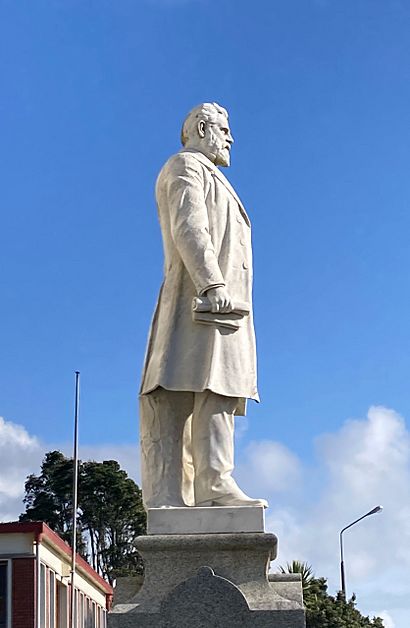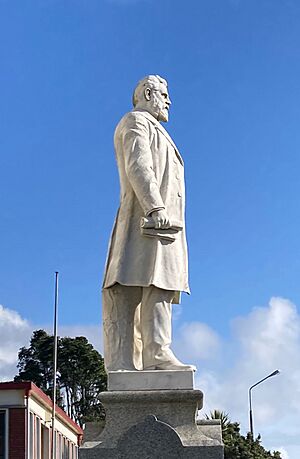Statue of Richard Seddon, Hokitika facts for kids
Quick facts for kids Statue of Richard Seddon |
|
|---|---|

Statue of Richard Seddon, outside Hokitika Government Buildings
|
|
| Artist | William Parkinson |
| Completion date | 25 May 1910 |
| Subject | Richard Seddon |
| Designation | Category II historic place |
| Location | Hokitika |
| 42°43′09″S 170°57′47″E / 42.7191°S 170.9630°E | |
| Designated: | 28 June 1990 |
| Reference #: | 4995 |
The Statue of Richard Seddon stands proudly in Hokitika, a town on the West Coast of New Zealand's South Island. You can find it on Sewell Street, right outside the old Government Buildings, which are also called Seddon House. This statue honors an important leader.
Contents
Who Was Richard Seddon?
Richard Seddon, often called "King Dick," was born in England. He came to Hokitika in 1866 after spending some time in Australia. He first worked in the goldfields, looking for gold.
Later, he opened a store and then became a publican, which means he ran a pub. His journey into politics started with local groups. He then joined the local council. In 1874, he became the mayor of Kumara.
Seddon's Political Career
Seddon was very successful in politics. In 1879, he was elected to Parliament. He became the Premier of New Zealand in 1893. He stayed in this powerful role until he passed away in 1906.
How the Statue Was Made
Two years after Seddon's death, in 1908, a group in Hokitika wanted to build a statue to remember him. This group was called the Seddon Memorial Committee. They asked the Hokitika Borough council for permission.
Funding the Statue
People in the community helped raise money for the statue. They collected £580 through public donations. This was a lot of money back then!
The committee then hired William Parkinson to create the statue. Parkinson owned a company called W. Parkinson & Co, which made monuments. He was from Auckland.
A Local Creation
It was quite special for the time that the statue was made in New Zealand. Most statues like this were made overseas. Parkinson had already shown his skill by designing and building the Hokitika Clock Tower a few years earlier. People really liked his work.
Statue's Location
The Government Buildings were being designed around the same time. The architect, John Campbell, made sure the building was set back 20 feet (about 6 meters). This created enough space for the statue to stand in front of it.
Unveiling the Statue
The statue was officially revealed on May 25, 1910. This special event took place outside the Government Buildings in Hokitika.
Speakers at the Event
Many important people spoke at the unveiling. Thomas Joseph Mcguigan, who led the memorial committee, spoke first. The main speaker was Joseph Ward, who became Premier after Seddon.
Henry Michel, the mayor of Hokitika, also spoke. He promised that the Hokitika Borough would take good care of the statue. Finally, Tom Seddon, Richard Seddon's son, spoke. He thanked the people of Westland for their kindness and for raising the money for the statue.
Statue's Inscription
Below the statue, there is an inscription that reads: "Richard John Seddon / P.C. L.L.D / Represented Westland in Parliament 1879–1906 / Prime Minister of New Zealand 1893–1906"
This tells us about Seddon's long service to the Westland area and his time as Prime Minister.
Who Owns the Statue?
In 1993, the Government Buildings and the statue were put up for sale. This caused a lot of discussion across New Zealand. People wanted the statue to remain public property.
Because of this, the statue stayed owned by the public. There was a suggestion in 1994 to move the statue to a different spot in Hokitika. However, it still stands in its original place today.
Historic Place Status
The New Zealand Historic Places Trust officially recognized the statue as a Category I item in June 1990. This means it is a place of special historical importance. Its registration number is 4995.
Why This Statue Is Important
There are about six monuments to Richard Seddon across New Zealand. But only two of them truly look like him. One is this statue in Hokitika. The other is in Wellington, made by Sir Thomas Brock, outside Parliament House, Wellington.
The Historic Places Trust says that the Hokitika statue is "a fine example of the realistic style of sculpture developed in Victorian times." This means it shows Seddon in a very lifelike way, just as people would have seen him.


